

Notes on The Catcher in the Rye Themes. Chapter 1 Lies and Imagination 1: Holden, in his wish to "feel some kind of good-by" (pg. 16) before he leaves Pencey, shows himself to be concerned with the authenticity of his own feelings.

He wants to use his imagination to feel more connected to the world and to his own emotions. Chapter 3 Lies and Imagination 2: Holden's inability to stay enrolled in school isn't a result of a lack of imagination--he's a fan of good books and seems interested in learning from them. It's almost as if he has too much imagination for school. Chapter 5 Lies and Imagination 3: The report Holden writes for Stradlater about his brother Allie's baseball mitt, shows that Holden has a poetic imagination.
Chapter 14 Lies and Imagination 4: A big part of Holden's trouble with movies is that they pollute peoples' imaginations. Chapter 18 Lies and Imagination 5: Holden's imagination isn't used just in the service of fantasies and escapism. Chapter 20 Chapter 22 Chapter 25 Lies and Imagination 8: It is unclear if Mr. Ducks, Fish, and Other Wildlife in The Catcher in the Rye. Holden just can’t let up about those ducks.
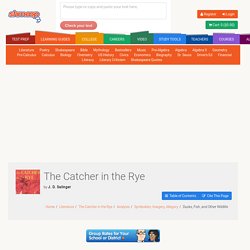
He asks his first cab driver if he “happen[s] to know where they go, the ducks, when it gets all frozen over? Do you happen to know, by any chance? " (9.4); and throws same question at a second cab drive a few chapters later (12.8). In his big breakdown moment, he stumbles drunkenly around the park looking to see “what the hell the ducks were doing, see if they were around or not” (20.38). What does the carousel mean in the catcher in the rye.? Simply put, the carousel goes around and around.

It never goes anywhere. It is a symbol of his stagnation in childhood. Holden, who would like nothing to change and everything to stay the same, now accepts that this is a childish dream. At the end of the story Holden does not choose to get on. He lets Phoebe go on and he is comfortable with this decision. In a way, the carousel is reminiscent of the statues in the Museum of Natural History, because, like them, it never changes.
But Holden does show some signs of growth. The Catcher in the Rye Themes. Hatred of Phonies "Phonies" is arguably the word most often associated with J.
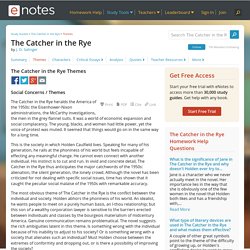
Phoebe. Holden's 10-year-old sister, Phoebe, is bright, pretty, mature beyond her years, sane, and his most trusted link to family.
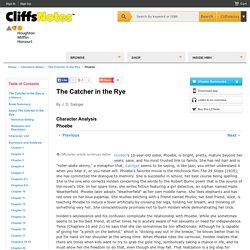
She has red hair and is "roller-skate skinny," a metaphor that, Salinger seems to be saying, is like jazz; you either understand it when you hear it, or you never will. Phoebe's favorite movie is the Hitchcock film The 39 Steps (1935); she has committed the dialogue to memory. The Catcher in the Rye Chapter 22 Summary. Once Holden comes back to Phoebe's room, she tries to ignore him.
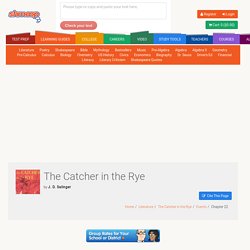
He assures her he's going to be fine on his ranch in Colorado, and harasses her about a stupid haircut somebody gave her.So why'd he get kicked out, anyway? A million reasons, Holden replies—mostly, everyone there was mean and phony. He can tell Phoebe is listening, even though she refuses to turn around and face him.Even the teachers were phony, like the way Mr.
Spencer would kill himself making jokes when the headmaster was sitting in on his class, or the alumni that would come back on Veteran's Day to see if the initials they carved into the bathroom wall were still there. He just didn't like it.Phoebe counters that Holden never likes anything, which (1) is true, and (2) makes him depressed. People who Shmooped this also Shmooped... THE CATCHER IN THE RYE: INTERNAL ASPECTS. Use of Language in Catcher in the Rye, English - CollegeTermPapers.com. Does Catcher In The Rye Brainwash People? Author J.D. Salinger immortalizes teen angst – MOVE Magazine. Guide Column: Author J.D.
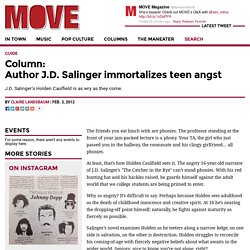
Salinger immortalizes teen angst J.D. Salinger’s Holden Caulfield is as wry as they come. Events For some reason, there aren't any events to display here. More stories The friends you eat lunch with are phonies. At least, that’s how Holden Caulfield sees it. Why so angsty? Salinger’s novel examines Holden as he teeters along a narrow ledge; on one side is salvation, on the other is destruction. "The Catcher in the Rye" spans exactly three days and 224 pages, but that tiny timeframe contains Holden’s personal journey of self-discovery — a series of moments in which he pinpoints his issues with adulthood and moves beyond them. The journey begins (as cliché as it sounds) at school. What this means is never exactly spelled out. Use of Language in Catcher in the Rye, English - CollegeTermPapers.com.